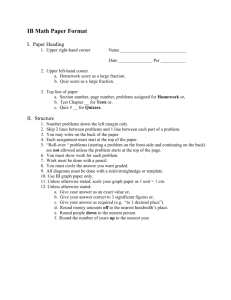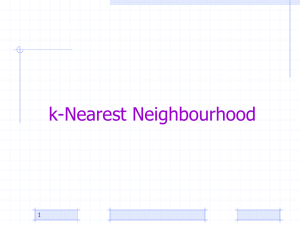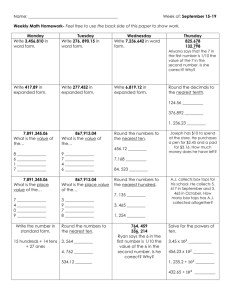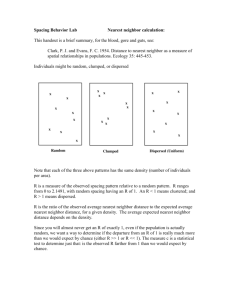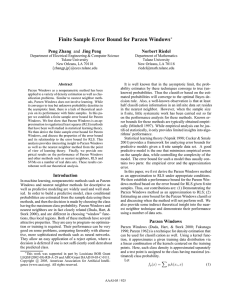Document
advertisement
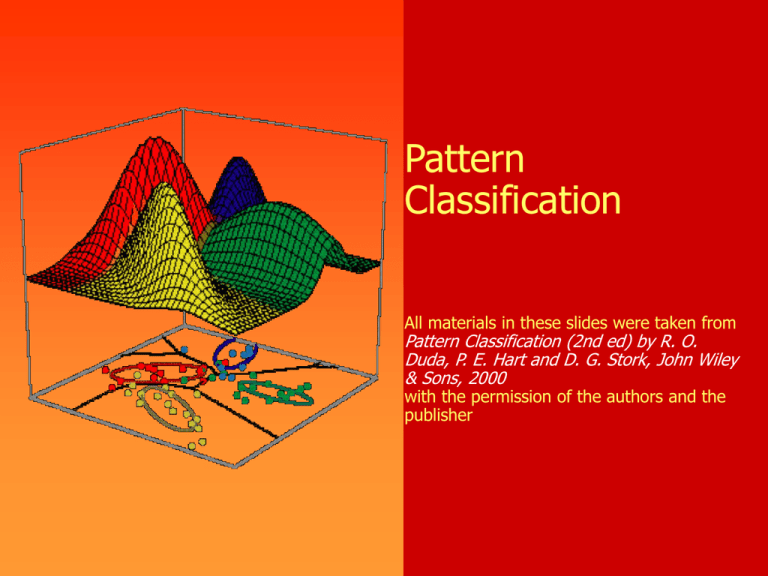
Pattern
Classification
All materials in these slides were taken from
Pattern Classification (2nd ed) by R. O.
Duda, P. E. Hart and D. G. Stork, John Wiley
& Sons, 2000
with the permission of the authors and the
publisher
Chapter 4 (part 2):
Non-Parametric Classification
(Sections 4.3-4.5)
• Parzen Window (cont.)
• Kn –Nearest Neighbor Estimation
• The Nearest-Neighbor Rule
2
Pattern Classification, Chapter 4 (Part 2)
Parzen Windows (cont.)
3
• Parzen Windows – Probabilistic Neural Networks
• Compute a Parzen estimate based on n patterns
• Patterns with d features sampled from c classes
• The input unit is connected to n patterns
x1
x2
Input unit
.
.
.
xd
..
.
W11
..
.
.
p1
p2
Wd2
Wdn
Modifiable weights (trained)
.
.
.
Input
patterns
pn
Pattern Classification, Chapter 4 (Part 2)
4
pn
Input
patterns
..
.
.
p1
p2
.
.
.
pk
.
.
.
pn
..
.
1
2
.
.
.
Category
units
c
Activations
(Emission of nonlinear functions)
Pattern Classification, Chapter 4 (Part 2)
5
•
Training the network
•
Algorithm
1. Normalize each pattern x of the training set to 1
2. Place the first training pattern on the input units
3. Set the weights linking the input units and the first pattern units
such that: w1 = x1
4. Make a single connection from the first pattern unit to the
category unit corresponding to the known class of that pattern
5. Repeat the process for all remaining training patterns by setting
the weights such that wk = xk (k = 1, 2, …, n)
We finally obtain the following network
Pattern Classification, Chapter 4 (Part 2)
6
Pattern Classification, Chapter 4 (Part 2)
7
•
Testing the network
•
Algorithm
1. Normalize the test pattern x and place it at the input units
2. Each pattern unit computes the inner product in order to yield
the net activation
t
net k w k .x
and emit a nonlinear function
net 1
f ( net k ) exp k 2
3. Each output unit sums the contributions from all pattern units
connected to it
n
Pn ( x | j ) i P ( j | x )
i 1
4. Classify by selecting the maximum value of Pn(x | j)
(j = 1, …, c)
Pattern Classification, Chapter 4 (Part 2)
8
• Kn - Nearest neighbor estimation
• Goal: a solution for the problem of the unknown “best” window
function
• Let the cell volume be a function of the training data
• Center a cell about x and let it grows until it captures kn samples
•
(kn = f(n))
kn are called the kn nearest-neighbors of x
2 possibilities can occur:
• Density is high near x; therefore the cell will be small which provides
•
a good resolution
Density is low; therefore the cell will grow large and stop until higher
density regions are reached
We can obtain a family of estimates by setting kn=k1/n and
choosing different values for k1
Pattern Classification, Chapter 4 (Part 2)
9
Pattern Classification, Chapter 4 (Part 2)
10
Pattern Classification, Chapter 4 (Part 2)
11
Illustration
For kn = n = 1 ; the estimate becomes:
Pn(x) = kn / n.Vn = 1 / V1 =1 / 2|x-x1|
Pattern Classification, Chapter 4 (Part 2)
12
Pattern Classification, Chapter 4 (Part 2)
13
Pattern Classification, Chapter 4 (Part 2)
14
• Estimation of a-posteriori probabilities
• Goal: estimate P(i | x) from a set of n labeled samples
• Let’s place a cell of volume V around x and capture k samples
• ki samples amongst k turned out to be labeled i then:
pn(x, i) = ki /n.V
An estimate for pn(i| x) is:
pn ( i | x )
pn ( x , i )
j c
p ( x ,
j 1
n
j
)
ki
k
Pattern Classification, Chapter 4 (Part 2)
15
• ki/k is the fraction of the samples within the cell that are
labeled i
• For minimum error rate, the most frequently represented
category within the cell is selected
• If k is large and the cell sufficiently small, the performance
will approach the best possible
Pattern Classification, Chapter 4 (Part 2)
16
• The nearest –neighbor rule
• Let Dn = {x1, x2, …, xn} be a set of n labeled prototypes
• Let x’ Dn be the closest prototype to a test point x then the
nearest-neighbor rule for classifying x is to assign it the label
associated with x’
• The nearest-neighbor rule leads to an error rate greater than the
minimum possible: the Bayes rate
• If the number of prototype is large (unlimited), the error rate of the
nearest-neighbor classifier is never worse than twice the Bayes rate
(it can be demonstrated!)
• If n , it is always possible to find x’ sufficiently close so that:
P(i | x’) P(i | x)
Pattern Classification, Chapter 4 (Part 2)
17
Example:
x = (0.68, 0.60)t
Prototypes
Labels
A-posteriori
probabilities estimated
(0.50, 0.30)
2
3
0.25
0.75 = P(m | x)
(0.70, 0.65)
5
6
0.70
0.30
Decision: is the label assigned to x
5
Pattern Classification, Chapter 4 (Part 2)
18
• If P(m | x) 1, then
the nearest neighbor
selection is almost always the same as the
Bayes selection
Pattern Classification, Chapter 4 (Part 2)
19
Pattern Classification, Chapter 4 (Part 2)
20
• The k – nearest-neighbor rule
• Goal: Classify x by assigning it the label most
frequently represented among the k nearest
samples and use a voting scheme
Pattern Classification, Chapter 4 (Part 2)
21
Pattern Classification, Chapter 4 (Part 2)
22
Example:
k = 3 (odd value) and x = (0.10, 0.25)t
Prototypes
(0.15,
(0.10,
(0.09,
(0.12,
0.35)
0.28)
0.30)
0.20)
Labels
1
2
5
2
Closest vectors to x with their labels are:
{(0.10, 0.28, 2); (0.12, 0.20, 2); (0.15, 0.35,1)}
One voting scheme assigns the label 2 to x since 2 is the most
frequently represented
Pattern Classification, Chapter 4 (Part 2)
23
Pattern Classification, Chapter 4 (Part 2)
24
4.6 Metrics and NN Classification
• Metrics = “distance” between patterns
• Four properties:
• Non-negativity D(a, b) ≧0
• Reflexivity
D(a, b) = 0 iff a = b
• Symmetry
D(a, b) = D(b, a)
• Triangle inequality D(a, b)+ D(b, c) ≧ D(a, c)
• Euclidean distance k=2
• Minkowski metric
• Manhattan distance k=1
1/ k
k
Lk (a, b) ai bi
i 1
d
Pattern Classification, Chapter 4 (Part 2)
Distance 1.0 from (0,0,0) for different k
25
Pattern Classification, Chapter 4 (Part 2)
Scaling the coordinates
26
Pattern Classification, Chapter 4 (Part 2)
27
Tanimoto metric
• Use in taxonomy
n1 n2 2n12
DTanimoto( S1 , S 2 )
n1 n2 n12
• Identical
• D(S1, S2) = 0
• Overlap 50%
• D(S1, S2) = (1+1-2*0.5)/(1+1-0.5)=1/1.5=0.666
• No intersection
• D(S1, S2) = 1
Pattern Classification, Chapter 4 (Part 2)
4.6.2 Tangent Distance
28
• Transformed patterns to be as similar as possible
• Linear approximation to the arbitrary transforms
• Perform each of the transformation Fi (x’; ai) on
each stored prototype x’.
• Tangent vector TVi
• TVi=Fi (x’; ai) - x’
• Tangent distance
• Dtan(x’, x) = min [ ||( x’ + Ta) – x|| ]
a
Tangent space
Pattern Classification, Chapter 4 (Part 2)
29
100-dim patterns
Hand write “8”
Shifted s pixels
Pattern Classification, Chapter 4 (Part 2)
30
Pattern Classification, Chapter 4 (Part 2)
31
Pattern Classification, Chapter 4 (Part 2)
4.8 Reduced Coulomb Energy Networks
32
• Parzen-window
• -> Fixed window
• K-NN
• -> adjusting the region based on the density
• RCE network
• -> adjust the size of the window during training
according to the distance to the nearest point of a
different category.
Pattern Classification, Chapter 4 (Part 2)
33
Pattern Classification, Chapter 4 (Part 2)
34
Pattern Classification, Chapter 4 (Part 2)
RCE Training
35
1. begin init j=0, λm=max radius
Train weight
2. do j = j + 1
3.
wij = xi
Find nearest
4.
=
arg
min
D(x,
x’)
x̂
point not in w
5.
λj = min[ D( x̂, x’) - ε, λm]
6.radius if x wk then ajk =1
Set
7. until j = n
Connect pattern and category
8. end
x wi
i
Pattern Classification, Chapter 4 (Part 2)
RCE Classification
1.
2.
3.
4.
5.
6.
7.
8.
Set of stored
prototypes
36
begin init j=0, k=0, x=test pattern, Dt={}
Prototype xj’
do j = j + 1
if D(x, xj’) < λj then Dt= Dt∪xj’
until j=n
Radius of xj’
if label of all xj’ Dt is the same
then return label of all xk Dt
else return “ambiguous” label
end
Pattern Classification, Chapter 4 (Part 2)
37
Summary
•
•
•
2 Nonparametric estimation approaches
1. Densities are estimated (then used for classification)
2. Category is chosen directly
Densities are estimated
•
Parzen windows, probabilistic neural networks
Category is chosen directly
•
K-nearest-neighbor, reduced coulomb energy networks
Pattern Classification, Chapter 4 (Part 2)
38
Pattern Classification, Chapter 4 (Part 2)
39
Class Exercises
• Ex. 13 p.159
• Ex. 3 p.201
• Write a C/C++/Java program that uses a k-nearest neighbor
method to classify input patterns. Use the table on p.209
as your training sample.
Experiment the program with the following data:
•
k=3
x1 = (0.33, 0.58, - 4.8)
x2 = (0.27, 1.0, - 2.68)
x3 = (- 0.44, 2.8, 6.20)
Do the same thing with k = 11
•
• Compare the classification results between k = 3 and k = 11
(use the most dominant class voting scheme amongst the k classes)
Pattern Classification, Chapter 4 (Part 2)
